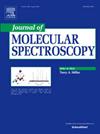喷射冷却溴乙酸和氯乙酸的微波光谱
IF 1.3
4区 物理与天体物理
Q4 PHYSICS, ATOMIC, MOLECULAR & CHEMICAL
引用次数: 0
摘要
得到了喷冷溴乙酸(CH2BrCOOH)和氯乙酸(CH2ClCOOH)的微波光谱。对于溴乙酸,观察到的光谱明确地归属于C-Br键几乎垂直于其他重原子所定义的平面的构象。这与先前在室温下观察到的构象不同,其中发现C-Br键在平面内。MP2和DFT计算预测了四种稳定的构象,观测到的构象与计算能量最低的构象相对应。确定了79Br和81Br核四极耦合张量的对角线和非对角线元素,并与计算结果相吻合。有趣的是,之前对氯乙酸的室温研究也揭示了C-Cl键在平面内的构象(即类似于对溴乙酸的室温研究)。因此,为了观察在室温和喷气冷却条件下观察到的构象之间是否存在相同的差异,我们还对喷气冷却氯乙酸的光谱进行了检查。在这种情况下,在射流中观察到的构象与之前在室温下报道的相同(平面内C-Cl键)。然而,所得到的光谱常数比以前确定的和在这里报告的要精确一些。由于超音速膨胀中的冷却作用,本研究中观察到的物质可能是两种酸的最低能量形式。与先前对氟,氯和溴乙酸的研究比较,突出了这些系统的复杂构象景观。本文章由计算机程序翻译,如有差异,请以英文原文为准。

Microwave spectra of jet-cooled bromo- and chloroacetic acids
Microwave spectra of jet-cooled bromoacetic acid (CH2BrCOOH) and chloroacetic acid (CH2ClCOOH) have been obtained. For bromoacetic acid, the observed spectra are definitively assigned to a conformer in which the C–Br bond is nearly perpendicular to the plane defined by the other heavy atoms. This differs from the conformer previously observed at room temperature in which the C–Br bond was found to be in the plane. MP2 and DFT calculations predict four stable conformations, and the observed form corresponds to that with the lowest calculated energy. Diagonal and off-diagonal elements of the 79Br and 81Br nuclear quadrupole coupling tensors have been determined and are in good agreement with the calculations. Interestingly, previous room temperature work on chloroacetic acid also revealed the conformation in which the C–Cl bond is in-plane (i.e., analogous to the room temperature work on bromoacetic acid). Thus, to see if the same disparity exists between the conformers observed under room temperature and jet-cooled conditions, the spectrum of jet-cooled chloroacetic was also examined. In this case, the conformer observed in the jet was the same as that previously reported at room temperature (in-plane C–Cl bond). The spectroscopic constants obtained, however, are somewhat more accurate than those previously determined and are reported here. Due to the cooling in the supersonic expansion, the species observed in this work are likely the lowest-energy forms for both acids. Comparison with prior studies on fluoro-, chloro-, and bromoacetic acids highlights a complex conformational landscape for these systems.
求助全文
通过发布文献求助,成功后即可免费获取论文全文。
去求助
来源期刊
CiteScore
2.70
自引率
21.40%
发文量
94
审稿时长
29 days
期刊介绍:
The Journal of Molecular Spectroscopy presents experimental and theoretical articles on all subjects relevant to molecular spectroscopy and its modern applications. An international medium for the publication of some of the most significant research in the field, the Journal of Molecular Spectroscopy is an invaluable resource for astrophysicists, chemists, physicists, engineers, and others involved in molecular spectroscopy research and practice.

 求助内容:
求助内容: 应助结果提醒方式:
应助结果提醒方式:


